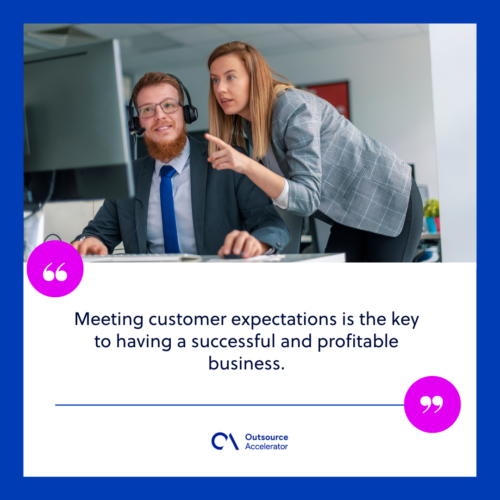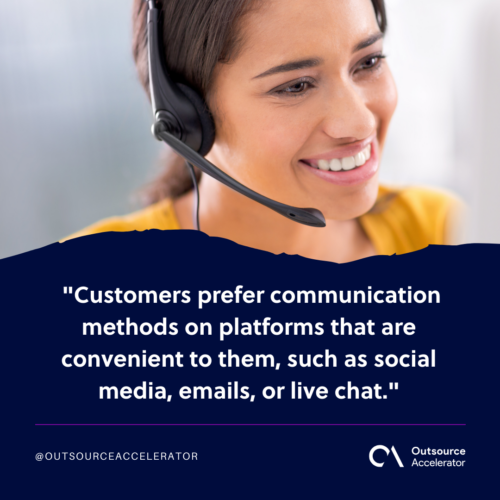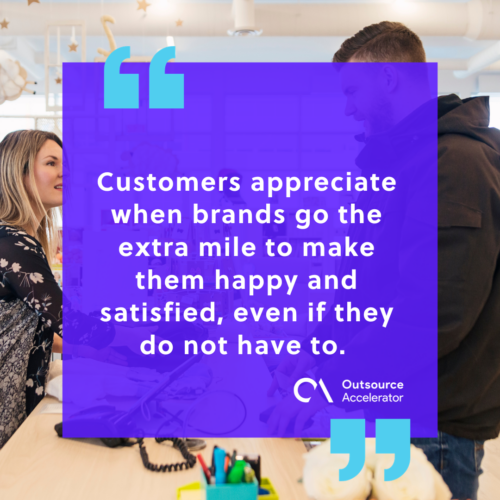Your guide to customer service expectations

Customers have their wants and needs. As a business entity, you are responsible for providing those for them.
These may be physical items like products or less tangible things like feelings of satisfaction and happiness.
Regardless of what they are, it is important to understand the different customer service expectations to give consumers the best experience possible.
What are customer expectations?
Customer service expectations can be described as how a customer expects to feel or respond to an interaction with a brand or product.
People have different expectations when it comes to how a company serves them. These can be in various aspects, such as waiting time, product quality, or simply how the brand makes them feel.
Why are customer service expectations important?
For some businesses, it only takes one customer who has not met their expectations not to return and to go to a competitor instead.
Meeting customer expectations is the key to having a successful and profitable business. It enhances the brand’s reputation when customers’ needs and issues are addressed and resolved, increasing their likelihood of returning and staying loyal.
Furthermore, meeting customers’ expectations encourages people to put in a good word for your business, ultimately attracting more customers and driving more profit.

6 common customer service expectations
Customers have different expectations, but the goal of the business is still the same – to meet them all.
Here are six common customer service expectations to be aware of:
1. Feeling heard and understood
Customers have their own problems, and they want them solved. The first step as a business is to hear them out.
Listen intently to their issues and assure the customers that their problems are heard. Ensure to gain their trust and let them understand that your services are what they need.
To some customers, buying a product or availing a service does not mean much, but it can go beyond a simple exchange to others.
When a customer hands you money, consider it as putting their utmost faith in you and your services. You do not want them to feel disappointed that their problems were not handled with care.
2. Quick and hassle-free service
Customers do not like to be kept waiting. Even just one inconvenience or hindrance to them getting the product or service can be enough to turn them away.
As a brand, you must prioritize delivering on your promises as quickly and efficiently as possible, especially if what they need is urgent.
Many external factors could slow things down or complicate the process. Therefore, businesses can help implement different strategies to work around these to reduce wait times. One example is using automation tools, which reduce the amount of manual labor.
There are times when in-demand services will lead to a high volume of customers, so it may take time to address them one by one. However, remember to never compromise on quality just to meet the deadline.
3. Making an effort and taking action
There are times when a product or service is below the customers’ expectations. However, there is still a chance for the business to make things right.
If a customer reaches out to you with an issue, it is not enough to apologize and say that the mistake will not happen again. Customers want businesses to do something about these issues.
The business’s priority is to ensure the customer’s journey ends with satisfaction. As an entrepreneur you may offer an alternative suggestion to a service, give a refund, or exchange a faulty product for a new one.
4. Easy and convenient communication channels
As mentioned earlier, customers do not like to wait and they want their problems addressed immediately.
One way to achieve this is through open communication channels that reach out directly to the business. Customers prefer communication methods on platforms that are convenient to them, such as social media, emails, or live chat.
Likewise, it is necessary for brands to implement these communication channels to prevent long waiting times.

5. User-friendliness
Customers do not want complicated solutions or services. There are times instructions are too difficult to understand or a certain process has so many steps that it may take too long to complete.
Therefore, it is ideal to make the experience easy and intuitive for the customer. This can be done through simplifying processes to make them easier to understand for the average customer.
Remember to keep your resources up to date so that your customers may have an easier time following instructions.
6. Transparency
The last thing you want is for your customers to feel like they have been misled, tricked, or let down. That is why transparency is a huge must in customer service.
Customers would rather choose a business who is honest about their shortcomings. This opens the door for genuine communication and efforts to make it up to the customer.
A brand who takes accountability for its mistakes is more reputable to a customer than one who tries to sweep things under the rug to take their money.
Types of customer service expectations
Meeting a customer’s expectations is not simply about making them feel a certain way. Here are five different types of customer service expectations to remember:
Explicit
Explicit expectations are those that the customer already has in mind before making a purchase. As the term suggests, these expectations are explicitly stated by the customer.
These are usually quantifiable and measurable. They include factors like price, delivery time, product quality, or certain specifications.
For example, a customer looking to buy a new mobile phone may ask for certain specifications at a certain price range. If a brand has a one that fits the description, then it is safe to say the customer’s expectations are met.
Implicit
Implicit expectations are more of assumptions that the customer makes about your product or service. These are based on several factors such as the following:
- What you know about the brand
- What others say about the brand
- Product reviews
- Customers’ past experiences with the brand
A customer usually considers all this information before forming their own opinions and assumptions.
Interpersonal
Interpersonal expectations refer to how customers expect their interactions with brands, such as personal interactions in a store, online interactions via live chat, or customer support.
Interpersonal expectations include factors like:
- How quickly a brand responds to customer calls
- How efficiently they address their issues
- Customer service representative’s attitude during the call
As mentioned previously, businesses must make it a priority to ensure the customer feels like they are heard and their problems are addressed and handled with care.
Digital
Digital expectations are your customer’s expectations when you interact with the brand online. This includes website visits, online chats, mobile apps, and social media engagement.
It is important for your customers to easily access your brand through these channels in order for them to have a quick and easy experience.
For example, if you run an online store, your customers must be able to easily access your products and place an order without complications.
Dynamic performance
Dynamic performance refers to how a customer reacts to product development or updates over time. They expect the business to evolve their products and still meet customers’ needs.
These are usually based on market changes and competitor behavior, which causes your business to adjust accordingly.
Tips to exceed customer expectations
Meeting customer expectations is important, but exceeding them should be the priority. Here are some ways to achieve that:
Self-service
Give your customers channels where they can answer their own questions, such as knowledge bases, chatbots, or updating your website content.
Doing so reduces waiting time and call volume, lessening the strain on customer service reps.
Customer-first mindset
The needs of the customers must come first. Internalizing a customer-first mindset will reflect your actions and allow you to address their needs.
Do not make the mistake of prioritizing profit. After all, there is no profit without customers.
Give more than what is expected
Giving the customers what they want and then moving on means doing the bare minimum, which is a common mistake. However, this approach comes off as impersonal.
Customers appreciate when brands go the extra mile to make them happy and satisfied, even if they do not have to. Doing so leaves a good and lasting impression that will make them come back.

Ask for feedback
Asking for feedback from customers shows that you are willing to take action, learn from your mistakes, and address any issue they have with your services.
You can use this chance to gain insights into what your customers really want and what areas you lack.
Increasing customer service expectations
The success of your company rides on meeting your customers’ expectations. If you fall short in any aspect, it could result in never seeing that customer again.
Take the time to learn more about your customers and establish a rapport with them so that you may respond accordingly to make them happy.







 Independent
Independent




